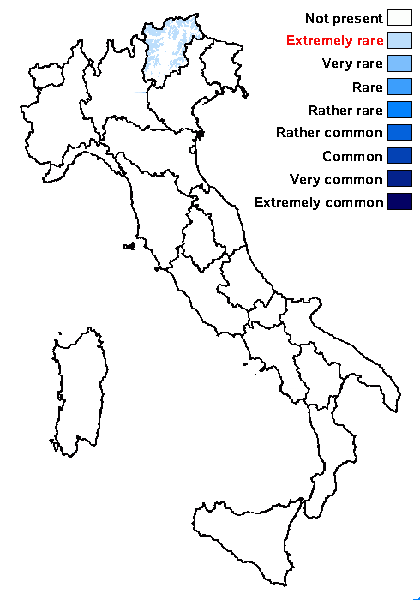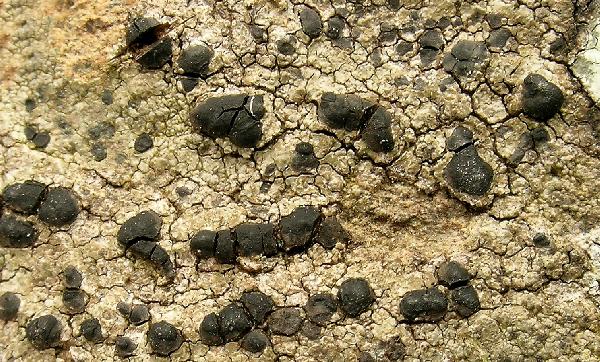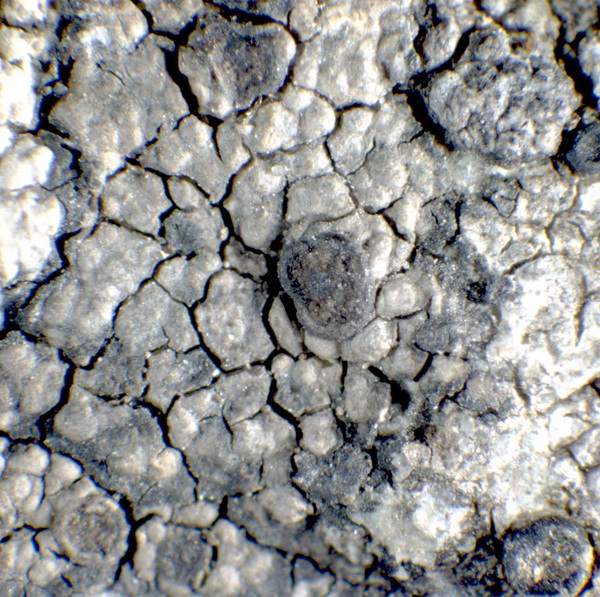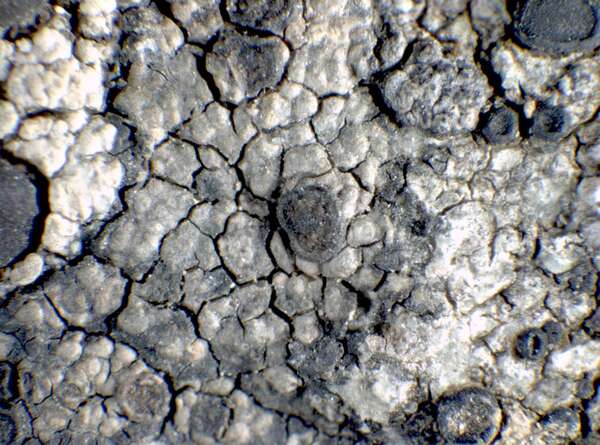Stereocaulon plicatile (Leight.) Fryday & Coppins
Lichenologist, 28: 513, 1996. Basionym: Lecidea plicatilis Leight. - Ann. Mag. nat. Hist., Ser. 4, 4: 201, 1869.
Synonyms: Rhizocarpon plicatile (Leight.) A.L.Sm.; Rhizocarpon rubescens Th.Fr.
Distribution: N - TAA (Dalla Torre & Sarnthein 1902).
Description: Thallus crustose, episubstratic, up to 0.2 mm thick, rimose to areolate, sorediate, the areoles 0.2-0.6 mm wide, confluent to scattered, flat to slightly convex, whitish to grey, rarely a few with darker centres. Soralia 0.2-0.3(-0.4) mm in diam., arising from cracks in the areoles, discrete to confluent, pale green to bluish green or brownish, the soredia c. 25-50 µm in diam., greenish white, but often brown-tinged, the surface hyphae brown-walled, the pigment K-, N-. Apothecia located among the areoles, (0.2-)0.6-1.2(-1.6) mm across, sessile, blackish brown to black, with a flat to slightly convex disc and a very thin, finally sometimes excluded proper margin. Proper exciple brown in outer part, colourless within, with crystals dissolving in K; epithecium brown, K-; hymenium colourless, (80-)90-100(-110) µm high; paraphyses simple, up to 1.5 µm thick at mid-level, the apical cell 3-4 µm wide, with a dark cap; hypothecium dark reddish brown, 40-70 µm high. Asci(4-)8-spored, cylindrical-clavate, with a K/I+ blue outer layer and apical dome, and a central, K/I+ darker blue tube, Porpidia-type. Ascospores submuriform or muriform, with 3-7 transverse septa and 1-6 cells with 1 (very rarely 2) longitudinal septa, hyaline, ovoid to fusiform, (20-)24-32 x 10-15 µm, without a distinct perispore. Pycnidia immersed in the areoles, dark reddish brown, globose. Conidia hyaline, thread-like, curved 14-18(-22) µm long. Photobiont chlorococcoid. Spot tests: soralia K+ yellow, C-, KC-, P+ orange, UV-. Chemistry: atranorin and stictic acid, the latter mainly confined to soralia. Note: on siliceous rocks and pebbles in damp habitats with a late snow-lie, either on vertical rocks in north-facing slopes or on stones and pebbles near cornice snow beds, near or above treeline; probably restricted to the Alps in Italy.
Growth form: Crustose
Substrata: rocks
Photobiont: green algae other than Trentepohlia (primary); cyanobacteria, filamentous (e.g. Nostoc, Scytonema) (secundary, e.g. in cephalodia)
Reproductive strategy: mainly sexual
Pioneer species
Commonnes-rarity: (info)
Alpine belt: extremely rare
Subalpine belt: extremely rare
Oromediterranean belt: absent
Montane belt: absent
Submediterranean belt: absent
Padanian area: absent
Humid submediterranean belt: absent
Humid mediterranean belt: absent
Dry mediterranean belt: absent

Predictive model
Herbarium samples
Growth form: Crustose
Substrata: rocks
Photobiont: green algae other than Trentepohlia (primary); cyanobacteria, filamentous (e.g. Nostoc, Scytonema) (secundary, e.g. in cephalodia)
Reproductive strategy: mainly sexual
Pioneer species
Commonnes-rarity: (info)
Alpine belt: extremely rare
Subalpine belt: extremely rare
Oromediterranean belt: absent
Montane belt: absent
Submediterranean belt: absent
Padanian area: absent
Humid submediterranean belt: absent
Humid mediterranean belt: absent
Dry mediterranean belt: absent

Predictive model
| Herbarium samples |
 INDEX FUNGORUM
INDEX FUNGORUM
 GBIF
GBIF
 DOLICHENS
DOLICHENS





